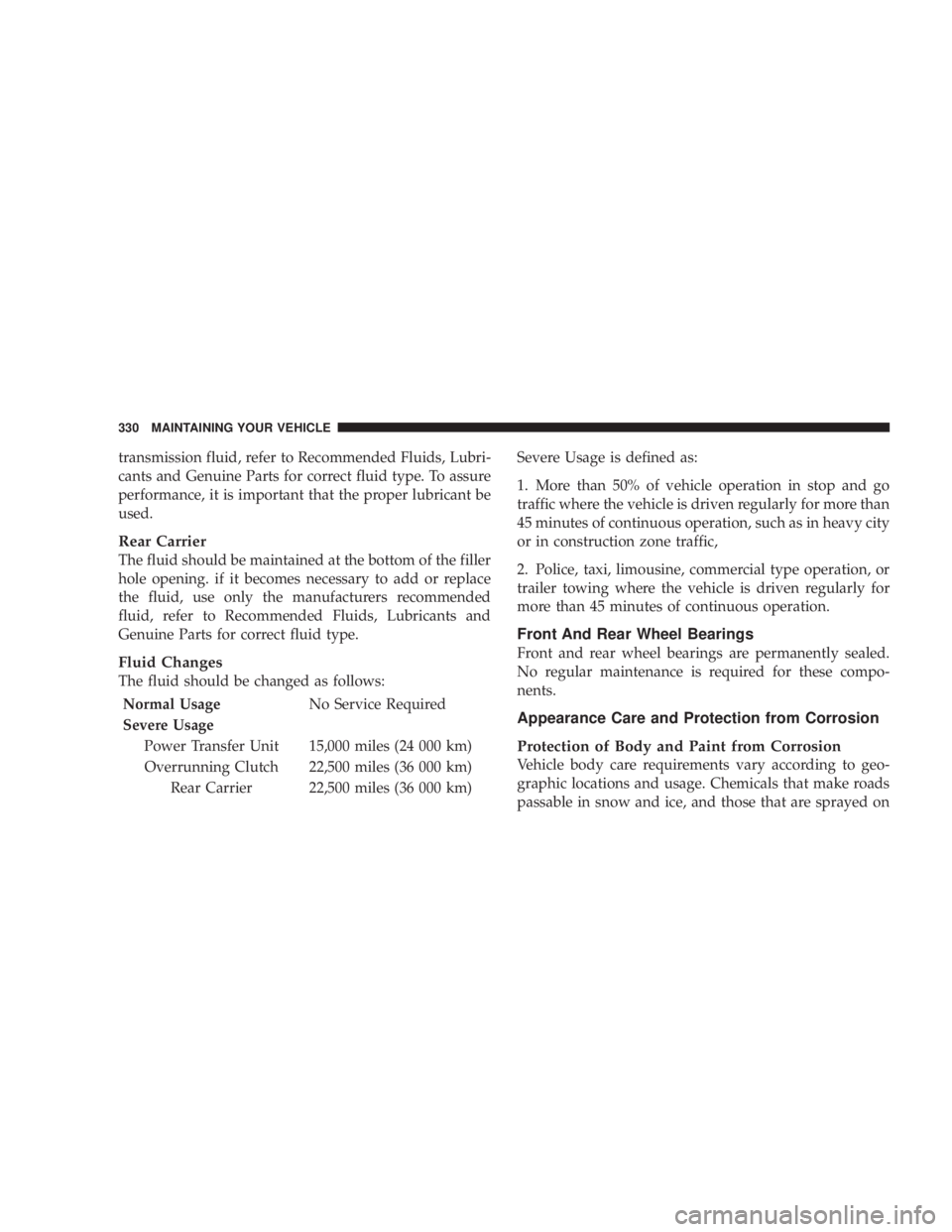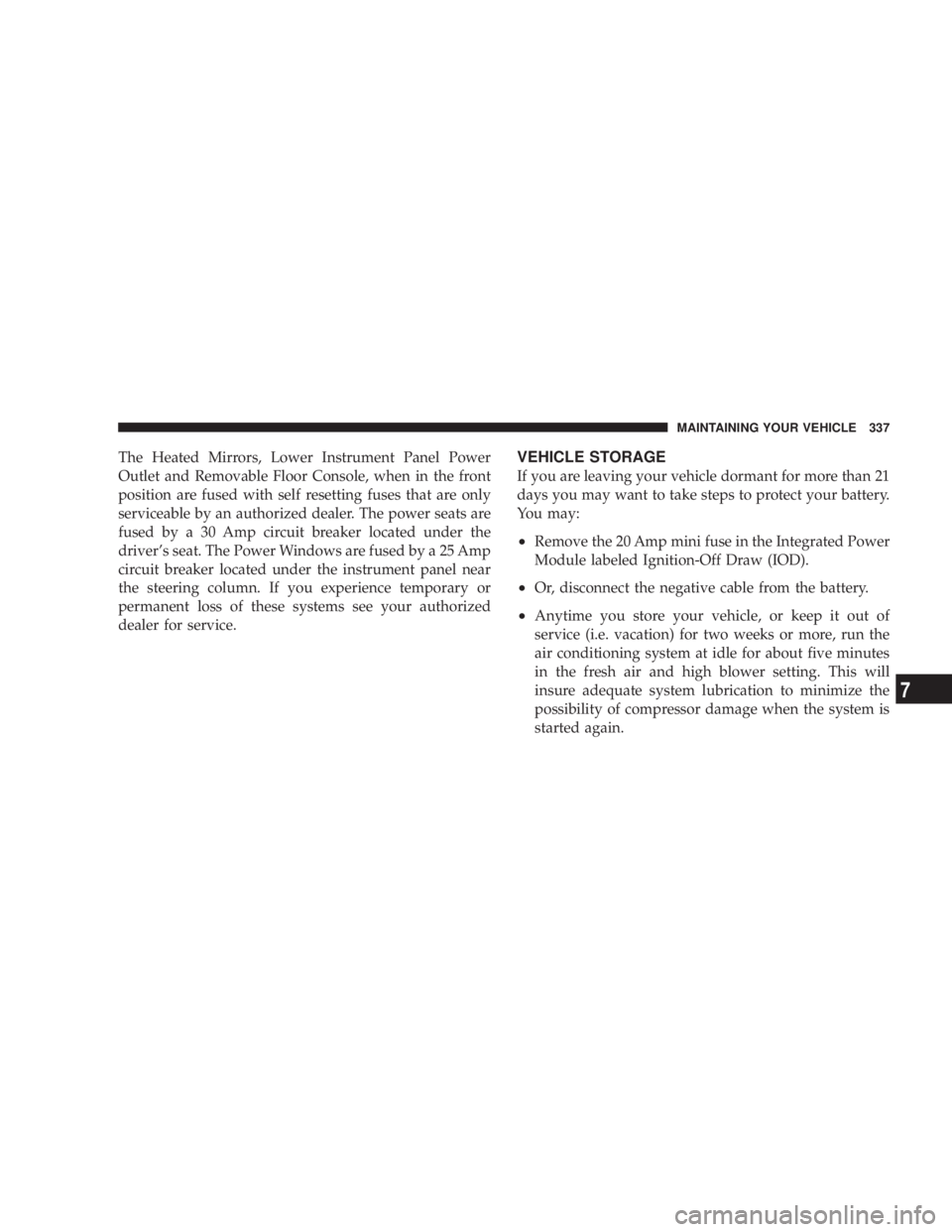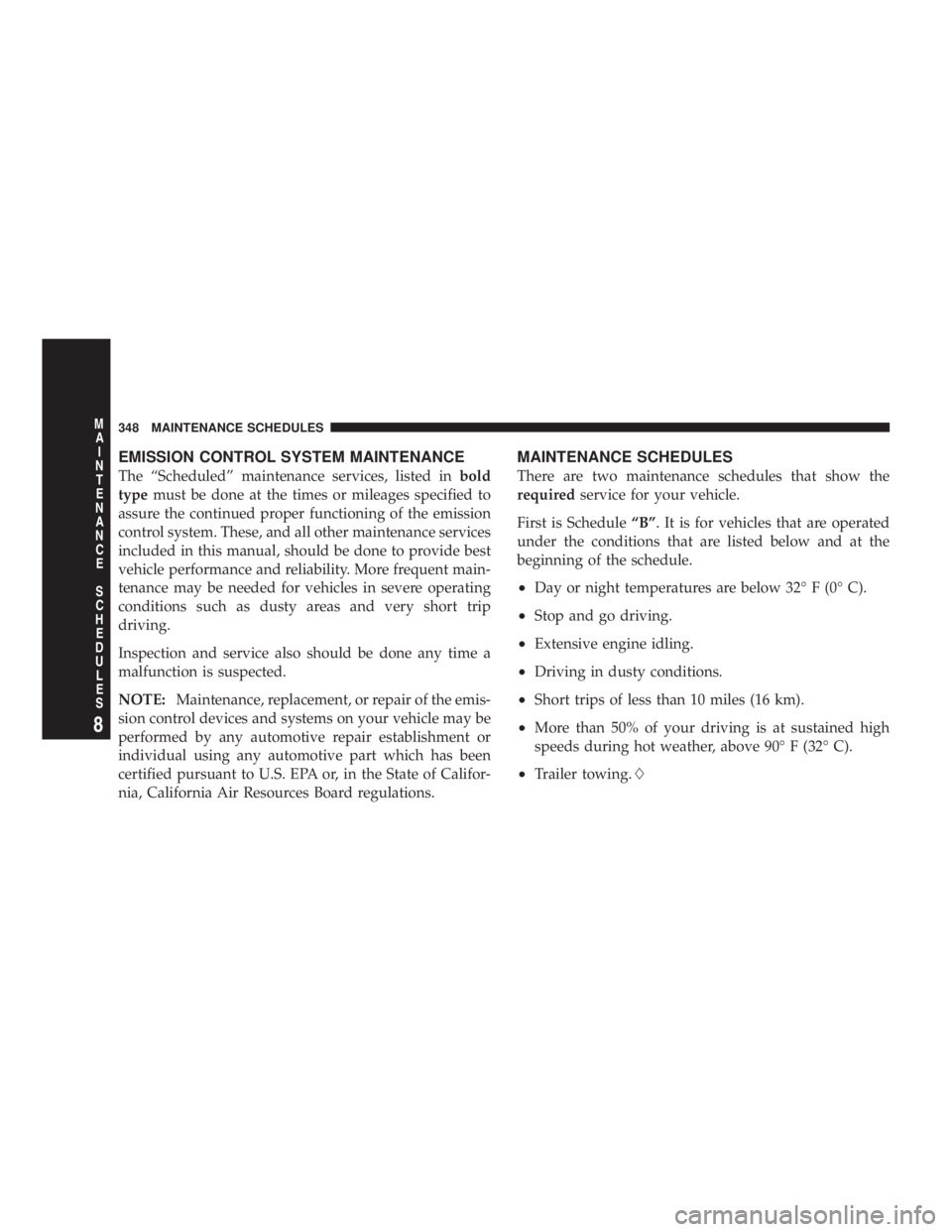Page 327 of 397

CAUTION!Using a transmission fluid other than the manufac-
turers recommended fluid may cause deterioration
in transmission shift quality and/or torque converter
shudder. Using a transmission fluid other than the
manufacturers recommended fluid will result in
more frequent fluid and filter changes. Refer to
Recommended Fluids, Lubricants and Genuine Parts
for correct fluid type. Procedure For Checking Fluid Level
The fluid level in the automatic transmission should be
checked whenever the vehicle is serviced. Operation with
an improper fluid level will greatly reduce the life of the
transmission and of the fluid.
To properly check the automatic transmission fluid level,
the following procedure must be used:
1. The vehicle must be on level ground.
2. The engine should be running at curb idle speed for a
minimum of 60 seconds.
3. Fully apply parking brake.
4. Place the gear selector momentarily in each gear
position ending with the lever in P (PARK). Wipe the area
around the dipstick clean to eliminate the possibility of
dirt entering the transmission. MAINTAINING YOUR VEHICLE 327
7
Page 329 of 397

NOTE: Refer to Section 8 of this manual for Mainte-
nance Schedules.
If the transmission is disassembled for any reason, the
fluid and filter should be changed.
Special Additives
Do not add any fluid additives to the transmission. The
only exception to this policy is the use of special dyes to
aid in detecting fluid leaks. The use of transmission
sealers should be avoided as they may adversely affect
seals. All Wheel Drive (AWD)
Under normal operating conditions, periodic fluid level
checks and lubricant changes for the Power Transfer
Unit, Overrunning Clutch and Rear Carrier, are not
required. However when the vehicle is serviced for other
reasons, the exterior surface of these components should
be inspected for evidence of fluid leaks. Confirmed leaks
should be repaired as soon as possible.
Power Transfer Unit
The fluid should be maintained at the bottom of the filler
hole opening. If it becomes necessary to add or replace
the fluid, use only the manufacturers recommended
fluid, refer to Recommended Fluids, Lubricants and
Genuine Parts for correct fluid type.
Overrunning Clutch
The fluid should be maintained at the bottom of the filler
hole opening. If it becomes necessary to add or replace
the fluid, use only the manufacturers recommended MAINTAINING YOUR VEHICLE 329
7
Page 330 of 397

transmission fluid, refer to Recommended Fluids, Lubri-
cants and Genuine Parts for correct fluid type. To assure
performance, it is important that the proper lubricant be
used.
Rear Carrier
The fluid should be maintained at the bottom of the filler
hole opening. if it becomes necessary to add or replace
the fluid, use only the manufacturers recommended
fluid, refer to Recommended Fluids, Lubricants and
Genuine Parts for correct fluid type.
Fluid Changes
The fluid should be changed as follows:
Normal Usage No Service Required
Severe Usage
Power Transfer Unit 15,000 miles (24 000 km)
Overrunning Clutch 22,500 miles (36 000 km)
Rear Carrier 22,500 miles (36 000 km) Severe Usage is defined as:
1. More than 50% of vehicle operation in stop and go
traffic where the vehicle is driven regularly for more than
45 minutes of continuous operation, such as in heavy city
or in construction zone traffic,
2. Police, taxi, limousine, commercial type operation, or
trailer towing where the vehicle is driven regularly for
more than 45 minutes of continuous operation.
Front And Rear Wheel Bearings
Front and rear wheel bearings are permanently sealed.
No regular maintenance is required for these compo-
nents.
Appearance Care and Protection from Corrosion
Protection of Body and Paint from Corrosion
Vehicle body care requirements vary according to geo-
graphic locations and usage. Chemicals that make roads
passable in snow and ice, and those that are sprayed on330 MAINTAINING YOUR VEHICLE
Page 337 of 397

The Heated Mirrors, Lower Instrument Panel Power
Outlet and Removable Floor Console, when in the front
position are fused with self resetting fuses that are only
serviceable by an authorized dealer. The power seats are
fused by a 30 Amp circuit breaker located under the
driver's seat. The Power Windows are fused by a 25 Amp
circuit breaker located under the instrument panel near
the steering column. If you experience temporary or
permanent loss of these systems see your authorized
dealer for service. VEHICLE STORAGE
If you are leaving your vehicle dormant for more than 21
days you may want to take steps to protect your battery.
You may:
² Remove the 20 Amp mini fuse in the Integrated Power
Module labeled Ignition-Off Draw (IOD).
² Or, disconnect the negative cable from the battery.
² Anytime you store your vehicle, or keep it out of
service (i.e. vacation) for two weeks or more, run the
air conditioning system at idle for about five minutes
in the fresh air and high blower setting. This will
insure adequate system lubrication to minimize the
possibility of compressor damage when the system is
started again. MAINTAINING YOUR VEHICLE 337
7
Page 348 of 397

EMISSION CONTROL SYSTEM MAINTENANCE
The ªScheduledº maintenance services, listed in bold
type must be done at the times or mileages specified to
assure the continued proper functioning of the emission
control system. These, and all other maintenance services
included in this manual, should be done to provide best
vehicle performance and reliability. More frequent main-
tenance may be needed for vehicles in severe operating
conditions such as dusty areas and very short trip
driving.
Inspection and service also should be done any time a
malfunction is suspected.
NOTE: Maintenance, replacement, or repair of the emis-
sion control devices and systems on your vehicle may be
performed by any automotive repair establishment or
individual using any automotive part which has been
certified pursuant to U.S. EPA or, in the State of Califor-
nia, California Air Resources Board regulations. MAINTENANCE SCHEDULES
There are two maintenance schedules that show the
required service for your vehicle.
First is Schedule ªBº . It is for vehicles that are operated
under the conditions that are listed below and at the
beginning of the schedule.
² Day or night temperatures are below 32É F (0É C).
² Stop and go driving.
² Extensive engine idling.
² Driving in dusty conditions.
² Short trips of less than 10 miles (16 km).
² More than 50% of your driving is at sustained high
speeds during hot weather, above 90É F (32É C).
² Trailer towing. L348 MAINTENANCE SCHEDULES
8 M
A
I
N
T
E
N
A
N
C
E
S
C
H
E
D
U
L
E
S
Page 349 of 397

² Taxi, police, or delivery service (commercial ser-
vice). L
² Off-road or desert operation.
NOTE: Most vehicles are operated under the conditions
listed for Schedule 9 B 9 .
Second is Schedule ªAº . It is for vehicles that are not
operated under any of the conditions listed under Sched-
ule 9 B 9 .
Use the schedule that best describes your driving condi-
tions. Where time and mileage are listed, follow the
interval that occurs first.
CAUTION!Failure to perform the required maintenance items
may result in damage to the vehicle. At Each Stop for Fuel
² Check the engine oil level about 5 minutes after a fully
warmed engine is shut off. Checking the oil level while
the vehicle is on level ground will improve the accu-
racy of the oil level reading. Add oil only when the
level is at or below the ADD or MIN mark.
² Check the windshield washer solvent and add if
required.
Once a Month
² Check tire pressure and look for unusual wear or
damage.
² Inspect the battery and clean and tighten the terminals
as required.
² Check the fluid levels of coolant reservoir, brake
master cylinder and transmission; add as needed.
² Check all lights and all other electrical items for correct
operation. MAINTENANCE SCHEDULES 349
8 M
A
I
N
T
E
N
A
N
C
E
S
C
H
E
D
U
L
E
S
Page 351 of 397
SCHEDULE ªBº
Follow schedule ªBº if you usually operate your vehicle
under one or more of the following conditions. Change
the automatic transmission fluid and filter every 60,000
miles (96 000 km) if the vehicle is usually operated under
one or more of the conditions marked with an L .
² Day or night temperatures are below 32É F (0É C).
² Stop and go driving.
² Extensive engine idling. ² Driving in dusty conditions.
² Short trips of less than 10 miles (16 km).
² More than 50% of your driving is at sustained high
speeds during hot weather, above 90É F (32É C).
² Trailer towing. L
² Taxi, police, or delivery service (commercial ser-
vice). L
² Off-road or desert operation. SCHEDULE ªBº 351
8 M
A
I
N
T
E
N
A
N
C
E
S
C
H
E
D
U
L
E
S
Page 362 of 397
Miles 108, 000 111, 000 114, 000 117, 000 120, 000
(Kilometers) (173 000) (178 000) (182 000) (187 000) (192 000)
Change the All Wheel Drive (AWD) power transfer
unit fluid. (See note at the end of this chart) X
Replace the air conditioning filter. X X
* This maintenance is recommended by the manufacture
to the owner but is not required to maintain the emis-
sions warranty.
³ This maintenance is not required if previously replaced.
Inspection and service should also be performed anytime
a malfunction is observed or suspected. Retain all re-
ceipts. NOTE: The AWD power transfer unit fluid and the
AWD overrunning clutch/ rear carrier fluid must be
changed at the intervals shown in schedule B if the
vehicle is operated under any of the conditions noted by
a diamond at the beginning of the schedule.362 SCHEDULE ªBº
8 M
A
I
N
T
E
N
A
N
C
E
S
C
H
E
D
U
L
E
S